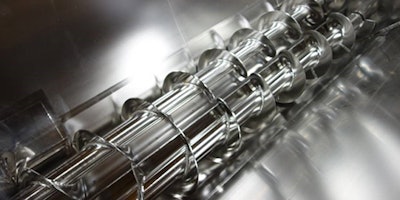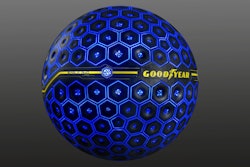
LEVERAGING STAINLESS STEEL FINISHES ON SANITARY EQUIPMENT
Leveraging Stainless Steel Finishes on
Sanitary Equipment
For many food and chemical producers, the level of finishing on process-
ing equipment may be prescribed by federal, state and local regulatory
agencies. In sanitary applications, however, the finish as well as the ma-
terial must also be designed for easy and reliable cleaning and sanitation.
Agencies require sanitary finishes to have a minimum RA (roughness av-
erage,) but processors are seeing the advantages of exceeding regulatory
compliance due to the decreased sanitation time and decreased bacteria
risk proven with higher-end finishes.
This white paper serves as an educational and informational reference to
include:
n Definitions of stainless finishes and measurement designations
n An overview of surface textures of stainless steels
n A guide to stainless steel finishes
n RA comparison data by finish type
For original equipment manufacturers, the level of complexity for stain-
less steel fabrication of sanitary equipment is significant. Each industry
requires experience and controlled processes for quality fabrication.
Tooling, process and technique are very important.
Discover the cleaning
efficiencies and
sanitation benefits
on a spectrum of
stainless steel finishes.
© Apache Stainless Equipment Corporation
The process for sanitary stainless steel fabrication
starts with the selection of the metal and handling of
the material. The fundamental process of working with
stainless steel with sanitary requirements includes
careful handling to prevent contamination from the
manufacturing environment and the use of protective
surfaces throughout all processes.
In sanitary applications, stainless steel equipment
requires a sanitary finish. The term “sanitary finish” in
general refers to a smooth, scratch-free, non-corro-
sive finish. There are several mechanical and chem-
ical finishes that can fulfill agency requirements for
sanitary specifications. In choosing the type of finish,
it is important to understand the definitions and crite-
ria for how finishes are designated.
Surface Texture The surface of the material including
irregularities and deviations, including roughness and
grain.
Grit is defined as the size of the abrasive used in the
polishing process. Typically coarse, lower grit numbers
are associated with grinding and higher grit numbers
are associated with polishing. Grit size however does
not fully define the surface.
RA (Roughness Average) A standard for an average of
the peaks and valleys of the metal’s surface, measured
in microinches or micrometers.
RMS (Root Mean Square) is a machining standard used
to diagnose machine operations and surface finish.
The fineness of the finish and ultimate success of the
sanitation effectiveness is measured in RA, the rough-
ness average measured by height in millionths of an
inch or microinches. A profilometer determines RA
values of small surface variations and calculates their
average to determine roughness.
RA Surface Textures of Stainless Steel Finishes*
Mill Finish
2B Mill Finish
No 3 Finish
No 4 Finish
No 4A/Dairy Finish
Bead Blasting
Mechanical Polishing
Electro-Polishing
Smoother Rougher
Microinches 1 10 20 30 40 50 60 70 80 90 100
+
*This chart
compares
RA surface
designations
in a range of
finishes. More
precise RA
values are
dependent on
the gauge of
material. Refer
to page seven
(7) for more
specific finish
designations
by gauge.
2 © Apache Stainless Equipment Corporation
There are two different methods for achieving a polished fin-
ish. The first is mechanical. Mechanical polishing involves the
removal of material using an abrasive, mechanical process.
Typically, grit sizes of 120 and finer are used for mechanical
polishing.
The other method for polishing is to use a chemical surface
treatment. Chemical treatments remove the outer layer of cor-
rosion in the material to preserve the integrity of the metal.
Below is a description of textures and finishes featuring both
mechanical and chemical methods, commonly used to produce
Apache’s tank and vessel processing equipment as well as the
Mepaco food processing equipment line.
Stainless Steel Textures & Finishes
Mill Finish A Mill Finish has an unpolished, dull-gray, matte
appearance. This finish forms the basis for supply condition
for all stainless steel flat products, and also forms the basis for
additional finishing operations. It is hot or cold rolled with a RA
of more than 100 microinches, depending on the gauge of the
material. (Gauge refers to cold rolled; plate is hot rolled material.)
2B Mill Finish This is a widely used stainless steel finish, com-
mon in industrial, chemical and food applications. It is corro-
sion resistant and has a typcial RA range of 40 (7 gauge) to 15
(16 gauge) microinches.
No. 3 Finish The No. 3 Finish uses a 120 grit abrasive. It has a
semi-polished finish with an RA range of 36 - 58 microinches.
No. 4 Finish This finish uses a 150 grit abrasive, and shows a
polished, brushed surface. The RA range is 29 - 40 microinches.
No. 4 Dairy / 4A Finish For processing industries, the number
4 Dairy is required to meet the basic 3-A standards. It uses a
180 grit and has a RA range of 18 - 31 microinches.
Bead Blasted The process of bead blasting utilizes bead
material such as glass, ceramic beads or dry ice to produce a
non-directional, textured surface with a soft satin appearance
and low-reflectivity. The finer the blasting media, the more
corrosion resistant the surface performance. The RA values
are typically greater than 45, but are dependent on the blasting
process and the stainless material.
Comparison Chart
...next
© Apache Stainless Equipment Corporation 3
A profilometer (RA meter) is used to measure the roughness
average of peaks and valleys in stainless material.
Stainless material with a mill finish has a rough, dull and
non-uniform appearance.
Mechanical polishers use an abrasive material (measured by
grit coarseness) to create the finish.
Providing a matte appearance, Apache has experienced
results in improved RA smoothness after the pickle
passivation, descaling process.
MECHANICAL FINISHES
The Apache Stainless Equipment Corporation Family
ASME Tanks . Small Vessels . Contract Manufacturing . Carbon Steel (Plover, WI) . Mepaco®
Mill Finish 2B Finish No. 4 Finish No. 4A Finish
Description
(Mill finish - Plate)
The baseline for comparison,
this is unfinished steel in
basic supply condition.
Applications
Structural
Sanitation Environment
None - not used in
food contact areas
RA
>100 microinches
Depending on material
Caution
Does not meet sanitary,
food contact or processing
finishing requirements
Description
(2B Finish -Gauge)
Common corrosion resistant,
heat resistant,
smooth, (not brushed) steel
Applications
Material handling,
processing,
direct food contact
Sanitation Environment
Suitable for caustic sanitary
wash down procedures
RA
36 (7 gauge) to 15 (16 gauge)
in microinches
Caution
Note that 2B finishes can
have the same RA as higher
end finishes depending on
gauge, compare econo-
mies when making material
decisions unless otherwise
required by compliance
factions.
Description
Characterized by short,
polished brushed lines
Applications
Used in clean rooms and in
food processing equipment
Sanitation Environment
Suitable for caustic sanitary
wash down procedures
RA
29 to 40 microinches
Caution
Note that a No. 4 finish is not
compliant for 3A standards;
a 4A finish will satisfy RA
requirements for the Dairy/
Cheese manufacturing
industy.
Description
Also characterized by short,
polished brushed lines, the
4A finish uses a
finer grit polish
Applications
Used in clean rooms,
processing equipment,
used in Pharmaceutical
industries and complies to
3A Dairy standards
Sanitation Environment
Suitable for caustic sanitary
wash down procedures
RA
18 - 31 microinches
(3A standards require
32 or less)
Caution
Welds are also required to be
ground to a No. 4A finish to
meet 3A Dairy standards
4 © Apache Stainless Equipment Corporation
© Apache Stainless Equipment Corporation
CHEMICAL FINISHES
Bead Blast Passivation Pickle
Passivation
Electro-
Polishing
Description
A uniform, non-directional,
low-reflective surface; bead
blasting can be mechanical
or chemical (dry ice)
Applications
Used when a uniform finish
is desired in structural,
material handling or food
handling applications
Sanitation Environment
Bead blasting on common
304 and 316 stainless
material is suitable for caustic
wash down procedures
RA
>45
depending on
blasting process
Caution
Bead blasting is not
necessarily a smooth finish,
the RA and smoothness
depends on the stainless
material used, the fineness
of the blasting media and the
blasting process.
Description
A chemical (typically nitric
or citrus acid) treatment that
produces a formation of a
protective passive film on
stainless steel
Applications
Most stainless steel material
is passivated, polished or
treated in some way to
prevent corrosion;
passivation may also be a
federal specification
Sanitation Environment
Passivated stainless material
can withstand caustic
wash down procedures
RA
RA values have
no significant improvement
after passivation*
Federal Specification No.
A-967
Description
Also referred to as descaling,
pickle passivation removes
the scale and leaves a clean
matte finish free from
contamination
Applications
Used in pharmaceutical
industries as a federal
specification and in food
processing industries to
reduce food safety risk
Sanitation Environment
Suitable for caustic,
aggressive sanitary wash
down environments
RA
Depending on material,
pickle passivation can
result in up to 25% increased
smoothness measured in RA*
Federal Specification No.
A-380
Description
Surface metal is dissolved,
removing all embedded
contaminants, creating a
smooth, mirror finish
Applications
Used in pharmaceutical in-
dustries as a federal specifi-
cation and in food processing
industries to prevent bacterial
attachment and reduce
food safety risk
Sanitation Environment
Highest grade of passive
surface available, can be
subjected to long term
caustic wash down
RA
Depending on material,
electropolishing can result
in up to 50% increased
smoothness measured in RA*
Federal Specification No.
B-912
5
Caution
Chemical passivation is a
protective treatment, not a
descaling process.
Caution
Partner with expert finishing
specialists who perform the
recommended procedures
for best results.
Caution
Partner with expert finishing
specialists who perform the
recommended procedures
for best results.
*Apache In-house finishing before/after tests; results vary
depending on stainless material.
Passivation Passivation is the removal of excess iron
or iron compounds from the surface of stainless steel
by means of a chemical, typically an acid based solu-
tion. Unlike pickle passivation, no metal is removed
from the surface during the process. The process has
little affect on the RA values of the stainless material
being passivated.
Pickle Passivation is the immersion of the metal in
a pickling bath or coating the material with pick-
ling solution, such as nitric-hydroflouric acid. The
process removes both metallic contamination and
heat-treating scales. Pickle passivated stainless
steel has a matte appearance. Apache’s tests have
confirmed improvements up to 25% in RA read-
ings on material that has been pickle passivated.
Electropolishing Electropolishing is an electro-
chemical process that removes surface materi-
al from stainless steel. The process includes an
immersion of the stainless steel component into a
temperature controlled bath of electrolyte that is
charged with a DC power supply. Electrolytes used
in electropolishing are concentrated sulfuric and
phosphoric acid solutions. The finish has a mirror
appearance. Apache’s before/after tests have shown
improvements in RA smoothness up to 50%; results
vary depending on stainless material.
While surface standards such as 3-A, requires
smooth, impervious material, free of cracks and
crevices, often processors need to choose the
finish that meets those requirements with the best
decision that fits their cleaning processes, risk fac-
tors and overall business objectives.
Below is a study, conducted at Apache, that com-
pares high-end finishes under 200X magnification.
It shows the RA smoothness in four finish examples
of 304 Stainless Steel. In the study, the Electro-
polished finish is more than six times smoother in
RA readings than the Bead Blasted finish. These
findings are only significant to the processor if
smoother finishes provide the benefit to cleaning
and sanitation in their manufacturing processes.
SURFACE SMOOTHNESS TEST UNDER 200X MAGNIFICATION
304 Stainless Steel 2B Finish
15 - 17 RA (12 gauge)
304 Stainless Steel
Electropolished Finish
5 - 6 RA
304 Stainless Steel 2B Finish
20 - 30 RA (10 gauge)
304 Stainless Steel Bead Blast
Finish 35 - 45 RA
6 © Apache Stainless Equipment Corporation
REFERENCE GUIDE
Steel & Finish Info Sheet
FINISH DESIGNATION
1-9 RA (1-10 RMS) #8
4-13 RA ( 5-15 RMS) 2B (16 Ga. Sheet)
9-18 RA (10 - 20 RMS) 2B (14 Ga. Sheet)
13 -22 RA (15-25 RMS) 2B (12 Ga. Sheet)
18-27 RA (20-30 RMS) 2B (11 Ga. Sheet)
18-31 RA (25-35 RMS) 2B (10 Ga. Sheet)
22-36 RA (25-40 RMS) 2B (7 Ga. Sheet)
10-16 RA (11-18 RMS) #7 (320 Grit)
13-27 RA (15-30 RMS) #6 (240 Grit)
18-31 RA (20-35 RMS) #4 Dairy (180 Grit)
29-40 RA (32-45 RMS) #4 (150 Grit)
36-58 RA (40-65 RMS) #3 (120 Grit)
49-76 RA (55-85 RMS) 2D (80 Grit)
STAINLESS STEEL GAUGE CHART
Gauge Decimal Size
28 .015
26 .018
24 .024
22 .030
20 .036
18 .048
16 .060
14 .075
13 .090
12 .105
11 .120
10 .135
8 .165
7 .1874
Since stainless steel resists corrosion, maintains its strength at high temperatures, and is eas-
ily maintained. It is widely used in items such as industrial and food processing products, as
well as medical and health equipment. The most common US grades of stainless steel are:
TYPE 304 / 304L
The most commonly specified austenitic (chromium-nickel stainless class) stainless steel, ac-
counting for more than half of the stainless steel produced in the world. This grade withstands
ordinary corrosion in architecture, is durable in typical food processing environments, and
resists most chemicals. Type 304 is available in virtually all product forms and finishes.
TYPE 316 / 316L
Austenitic (chromium-nickel stainless class) stainless steel containing 2%-3% molybdenum
(whereas 304 has none). The inclusion of molybdenum gives 316 greater resistance to various
forms of deterioration.
© Apache Stainless Equipment Corporation 7
Note: The thinner the gauge material, the more rolling processes
and cold reduction the material is subjected to, which creates a
smoother surface.
References:
The Fabricator, A publication of the Fabricators & Manufacturers
Association, Intl.
ISSF, International Stainless Steel Forum
ASTM, International Standards Worldwide
USDA Agricultural Research Service
3-A, Basics of Sanitary Design
Apache and Mepaco industry experts and reference documents
Apache’s food processing customers have more
discretion in choosing equipment finishes even
in food contact environments. The type of food
product, bacterial count, manufacturing function
and sanitation procedures all have an impact
on the requirements as well as the selection of
equipment finishes.
When weighing the advantages of food contact
equipment finishes, the U.S. Dept. of Agriculture
and Research Service offers a study conducted
by the American Society of Mechanical Engi-
neers on electropolishing and surface finishes. In
the research, samples of stainless steel finishes
were exposed to bacteria to allow growth. As
microorganisms became attached to surfaces,
they became more resistant to both physical and
chemical sanitation practices. It was determined
that out of eleven different finishes tested, the
electropolished finish was the most resistant sur-
face to bacterial attachment.
About Apache
The Apache Stainless Equipment Corporation
employs experts and artisans in the fabrication of
stainless equipment for a range of industries. Our
expertise in high-end stainless finishes is shown on
Apache’s tanks and vessels, and Mepaco’s food
processing equipment used in the beverage, bio-
technology, pharmaceutical and food processing
industries.
Passivation, pickle passivation and electropolish-
ing processes are offered in-house by experienced
technicians; there is no dependency on outsourc-
ing. Apache provides finishing services on tanks,
vessels and food processing equipment as well as
contract finishing requests.
Apache consists of four business groups: ASME
tanks, portable vessels, contract manufacturing and
Mepaco®. With modifiable options, Mepaco’s prod-
uct line includes: thermal processing equipment,
mixers, blenders, augers, dumpers, sanitary con-
veyors and material handling systems.
As a 100% employee owned company, Apache’s
culture exemplifies continuous improvement, effi-
ciency, innovation and commitment to our
customer.
OSHA | PIP (Process Industry Practice) | ASME & API-650
Phone: (920) 356-9900 or (800) 444-0398
E-mail: [email protected]
Web: www.apachestainless.com
200 W. Industrial Drive | Beaver Dam, WI 53916 USA
A portable vessel used in the pharmaceutical manufacturing
industry emerges from the electropolishing tank at Apache
Stainless Equipment Corporation.






















